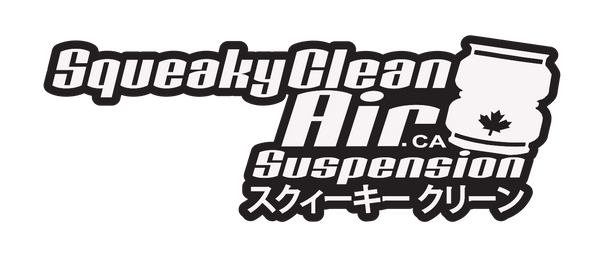TECHNICAL INFO
Important Post-Installation Checks for Air Struts
CAUTION: COMPRESSED AIR COMPONENT
Install by qualified professionals only.
Do not exceed rated PSI. SqueakyClean is not responsible for misuse or improper installation.
1. Verify Locking Collars
- Before lowering the vehicle, tighten all locking collars — especially the lower mounts and the collars under the air bag.
- Use significant force to ensure they’re fully secured. This prevents noise, play, or looseness while driving.
2. Torque Front Top Mount Rod Nuts
-Once the vehicle is on the ground, recheck and torque the front top mount center rod nuts:
12mm nuts: 75 lb-ft
10mm nuts: 40 lb-ft
Periodically inspect these nuts for tightness. If any loosen over time, remove them, apply red threadlocker, and retorque to spec.
3. Orienting the Upper Strut Mount
- Remove the top dampening adjuster (slide out or loosen via small Allen key).
- Loosen the center top nut to reorient the upper mount for your chassis (if not pillowball-type).
- Pillowball mounts can simply be rotated into position.
- Tighten to approximately 75 lb-ft 12mm, 40 lb-ft 10mm, but do not over-tighten — overtightening may damage the sealing O-ring.
4. Airline Routing
- Route all front stainless or air lines behind the strut, toward the engine, and away from wheels or obstructions to prevent rubbing or air leaks.
5. Adjusting Ride Height
- To adjust air strut length, use the lower mount threads only.
- Never unthread or spin the air bag from the damper insert.
- After adjusting, fine-tune dampening settings during a test drive for optimal comfort and performance.
6. Final Inspection
- Double-check all suspension bolts loosened during installation and torque them to the manufacturer’s specifications.
- Re-inspect periodically for safety and performance.
Need Assistance?
For support, contact us on Instagram @squeakycleanair or email orders@squeakycleanair.ca.
For ride quality tips, strut adjustment guides, and event coverage, subscribe to our YouTube channel: SqueakyClean Suspension.
- Top pillowball upper nut tips, bags & coils- YouTube
- How to adjust your air struts for best ride - YouTube
SqueakyClean Air Digital Preset Management.
SqueakyClean Suspension Digital Management Android App Ver. 1.1.
SqueakyClean Suspension Digital Management compatible Apple App.
(Please note this is a third party app that will work with our management, available from the apple store)




